
May 2022
Finally!
The First Commercially Successful Gas Engine
By Paul Harvey
The gas engineís humble beginnings date back to 12th century China when
the cannon was invented. Already
having produced gunpowder, a weapon was not a surprising use of their
new explosive. The cannon worked
well and was built in many sizes and configurations.
But all had two things in common:
a barrel and a projectile. Seems simple!
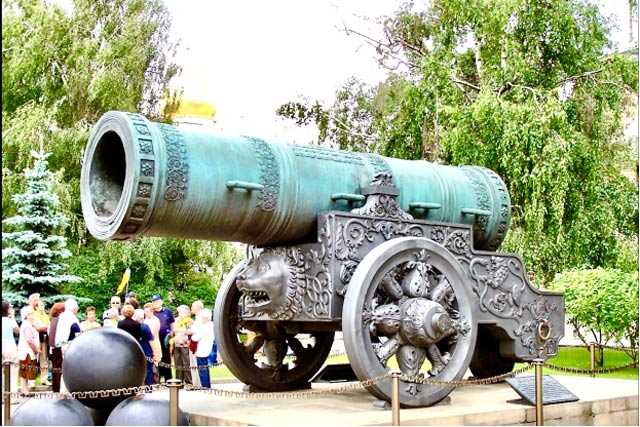
Hmmm. Many years went by, but
gradually thought was given to peaceful and useful adaptations.
Now letís see; that barrel could
become a cylinder, and the cannon ball a piston.
So, the inventors went to work to
construct some mechanism to make a piston go back and forth and hook it
up to make rotary motion. Centuries
went by before it happened.
Now letís jump ahead to the 1700s. Gosh,
thatís 500 years from that innovation of that cannon.
But an era of enlightenment had
awakened with the great Industrial Revolution dating about 1760 to 1840.
So much invention had already
started in the early 1700s. Finally,
that cannon barrel and ball was put to productive use!
In 1712, Thomas Newcomen, of England, developed the first commercially
successful engine to use the piston and cylinder.
It produced a reciprocating
motion that was widely adapted to pump water from mines.
Operated by steam, it burnt wood
or coal for its boiler.

By 1763, James Watt invented the connecting rod and crankshaft to
provide a rotary motion. The
modern steam engine had been invented! Now,
what next?
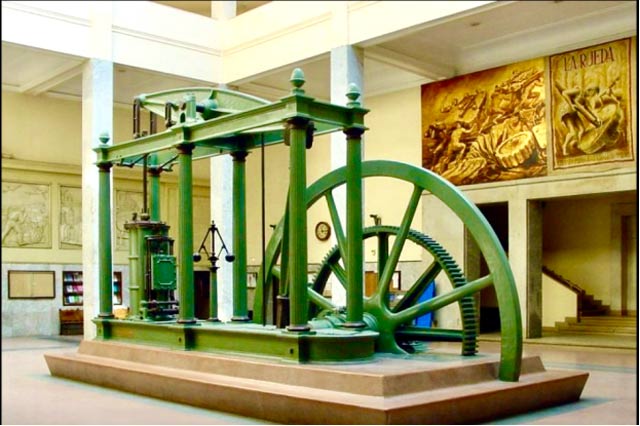
During the Industrial Revolution, a prolific amount of invention took
place. The early and mid-1800s
saw a concentration on the internal combustion engine.
Why burn the fuel externally to
make steam when it could be burned directly in the cylinder to make
power? Good idea, but how to make
it happen? So many ideas and
prototypes, but they all had problems. None
reached commercial success.
But wait! In 1860, a
Belgian-French engineer, Etienne Lenoir, succeeded.
He built the first commercially
successful gas engine! Here is
his story.

Jean Joseph Etienne Lenoir was born on January 12, 1822 in the village
of Mussy-la-Ville, then a part of Luxembourg.
He was the third child of eight
whose father was Jean-Louis Lenoir, a merchant, and whose mother was
Margot Megdelaine, a housewife. He
left the tiny village of 800 souls at an early age, destined to become
an inventor, and worked as a farm hand on his journey to Paris. There,
he worked as a waiter and became interested in electricity.
By much self-study, he became an
accomplished engineer. Turning to
the gas engine, he had a running prototype built in 1858 and was granted
a patent for it in 1860. It was a
commercial success, and although fuel inefficient, many were sold throughout
France and put to useful work. By
1864, over 130 were working in Paris itself.
Total production was about 500
engines and a German license had been issued.
His destiny was fulfilled.
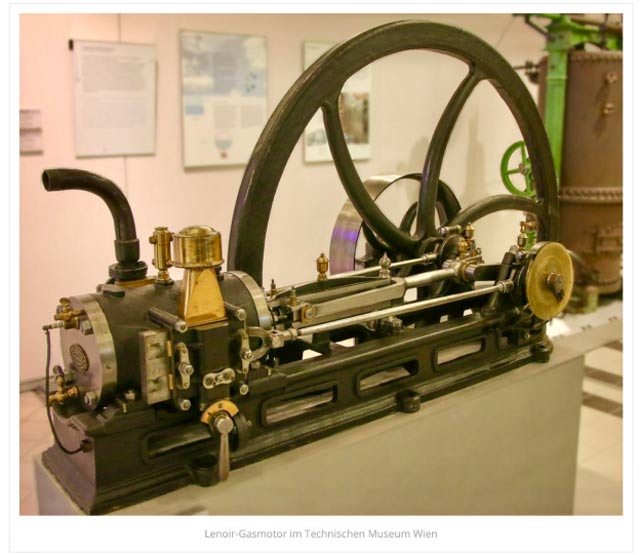
Beautiful machine, but how does it work?
Well, itís quite simple to us now but very advanced for its
time. At that time, the Otto
cycle of compressing the charge was not invented yet; it had to wait
another 20 years. So, it was a
non-compressing two-cycle engine. But
he made it double acting, so it fired on both sides of the piston.
Hmmm, could create a cooling
problem so plenty of water had to be flowed through the cylinder.
Double slide valves, one on each
side of the cylinder, were used for the intake and exhaust functions.
Refer to the following
illustration.

Pipe G is the gas intake and pipe E is the air, mixing and introduced
into the cylinder by the slide valve shown.
A similar slide valve for the
exhaust function is on the other side of the cylinder.
It worked very well.
But what is the device shown along the engine base?
Yep, itís a coil and batteries.
In 1858 Lenoir invented the spark
plug, calling it ďjumping sparks.Ē He
used the newly invented Ruhmkorff
coil to do this!

Invented by Heinrich Ruhmkorff, the coil is known to all engine
folks as a ďbuzz coil.Ē Henry
Ford used them for his Model T ignition.
Sadly, Lenoirís use of the spark plug was abandoned in favor of
open flame ignition and hot tube ignition for so many years.
Lenoir was truly a genius and
built a wonderful machine.
Here are three views of the Lenoir engine in Deutz Technikum in Cologne,
Germany. It is operated for the
museumís many visitors.
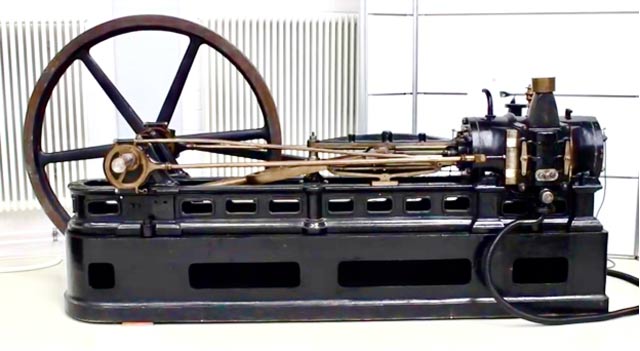
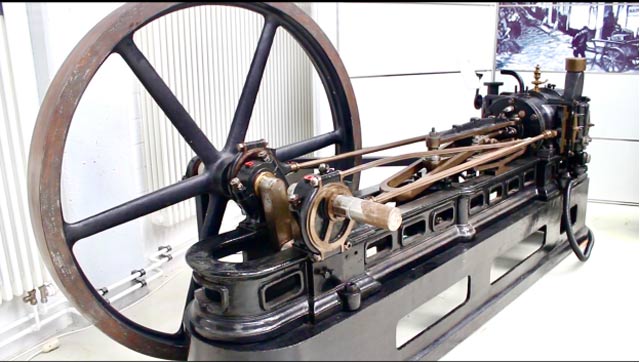
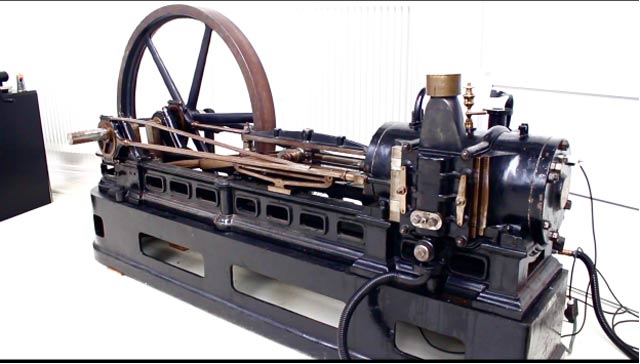
Note the two slide valves, operated by eccentrics, located on either
side of the cylinder, and the spark plugs for ignition.
Amazingly, these engines were
built to 20 hp!
But Lenoir was not satisfied with stationary engine.
He built an automobile!
Yep, his car, the Hippomobile,
was on the road in 1863. He
installed a 1.5 hp version of his engine into this tricycle frame and
used liquid fuel by a primitive patented carburetor.
It covered the seven-mile course
from Paris to Joinville-le-Pont and back in 90 minutes, at the breakneck
speed of 3 km/hr. Slow, yes, but
it was successful! A new era had
begun.

He still was not satisfied so he turned to motorboats.
Installing an improved version of
his engine in a 12-meter-long boat for a Mr. Dalloz, it was used on the
Siene River for the next two years.
These two images from Lenoirís US patent illustrate how the engine
operated. The reader can access
the
entire patent on Google Patents. The
engineís design is graceful and very pleasing, and was copied for future
generations of engines.
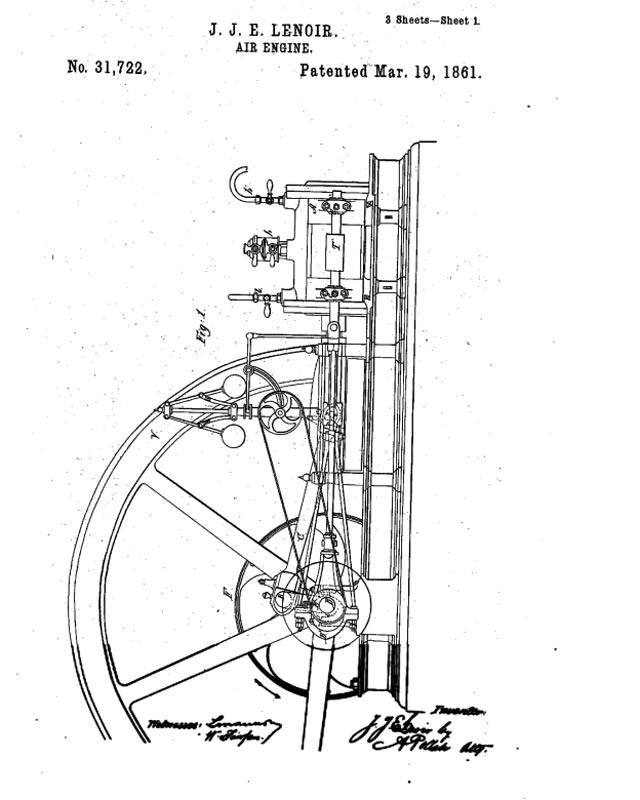
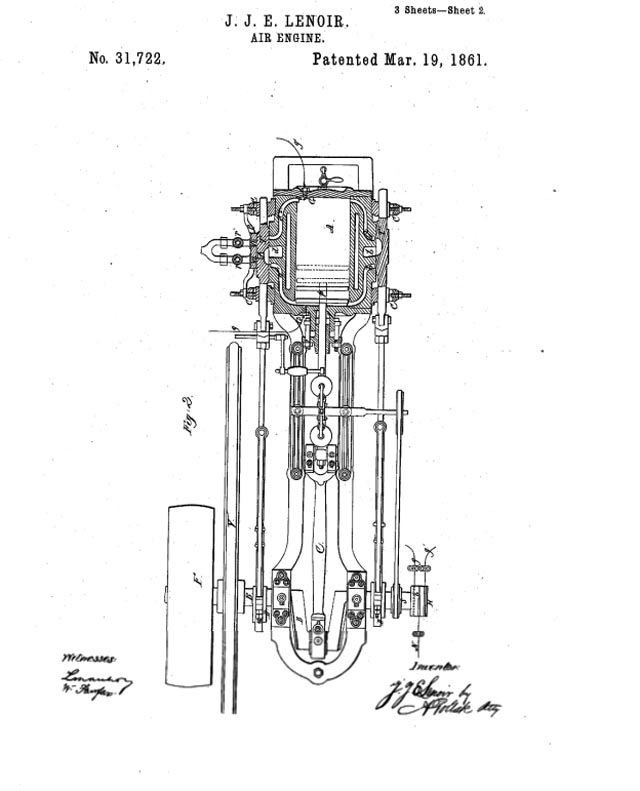
The two slide valves are illustrated as well as the graceful governor.
It was a job well done!
Lenoir spent the rest of his life in peaceful prosperity in his
apartment in Paris. He often went fly fishing in the nearby Seine, but
remained active and followed the further development of the combustion
engine with interest. Jean Joseph
Etienne Lenoir quietly passed away on August 4, 1900.
